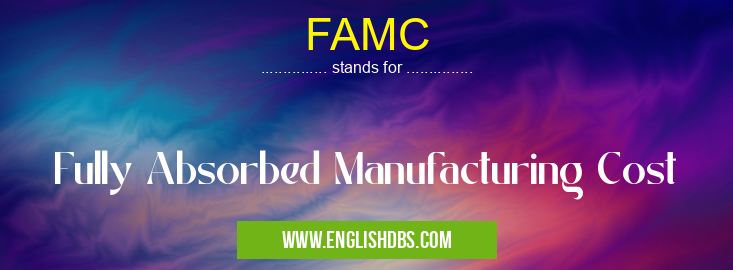What does FAMC mean in MANUFACTURING
FAMC stands for Fully Absorbed Manufacturing Cost. It is a costing method that includes all the costs associated with the production of a product. This includes direct costs (such as materials and labor) as well as indirect costs (such as overhead and administrative expenses).

FAMC meaning in Manufacturing in Miscellaneous
FAMC mostly used in an acronym Manufacturing in Category Miscellaneous that means Fully Absorbed Manufacturing Cost
Shorthand: FAMC,
Full Form: Fully Absorbed Manufacturing Cost
For more information of "Fully Absorbed Manufacturing Cost", see the section below.
Calculation of FAMC
To calculate the FAMC, all of the costs associated with production are added together and divided by the total number of units produced. This gives the cost per unit.
Advantages of FAMC
- Accurate Costing: FAMC provides a more accurate picture of the cost of a product because it includes all of the costs associated with production.
- Improved Decision Making: FAMC can help businesses make better decisions about pricing, production, and other aspects of their operations.
- Easier Budgeting: FAMC can make it easier for businesses to budget for their operations because it provides a more comprehensive view of the costs associated with production.
Disadvantages of FAMC
- Complex Calculations: FAMC can be more complex to calculate than other costing methods.
- Time-Consuming: It can be time-consuming to collect all of the data necessary to calculate FAMC.
- Not Always Necessary: FAMC is not always necessary for businesses that produce a limited number of products.
Essential Questions and Answers on Fully Absorbed Manufacturing Cost in "MISCELLANEOUS»MANUFACTURING"
What is Fully Absorbed Manufacturing Cost (FAMC)?
FAMC is a costing method that allocates all manufacturing costs, both direct and indirect, to the units produced. It ensures that all manufacturing expenses are accounted for in the final product cost, leading to more accurate product pricing and inventory valuation.
How does FAMC differ from Variable Costing?
Unlike FAMC, variable costing only assigns variable manufacturing costs to the units produced. Fixed manufacturing costs are treated as period costs and expensed in the period incurred. This method can result in lower per-unit costs and higher reported profits in periods of low production.
What are the advantages of using FAMC?
FAMC provides a more accurate representation of product costs, as it considers all manufacturing expenses, including indirect costs like overhead and depreciation. It also facilitates better inventory valuation and cost control, by ensuring that all costs associated with producing the inventory are accounted for.
What are the disadvantages of using FAMC?
FAMC can potentially lead to higher per-unit costs, especially in periods of low production, as fixed manufacturing costs are allocated to the units regardless of the production volume. It can also make it more difficult to identify the impact of variable costs on profitability.
When is it appropriate to use FAMC?
FAMC is particularly suitable for businesses with high fixed manufacturing costs and low product variability. It is often used in industries where accurate cost accounting is crucial, such as manufacturing, construction, and utilities.
Final Words: FAMC is a costing method that can provide businesses with a more accurate picture of the cost of a product. It can help businesses make better decisions about pricing, production, and other aspects of their operations. However, FAMC can be complex and time-consuming to calculate, so it is not always necessary for businesses that produce a limited number of products.
